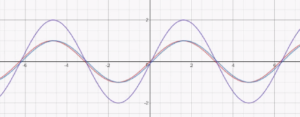Question: What is phase cancellation?
Answer: Phase is the difference in time and amplitude between two sources. All sound waves consist of positive and negative movement, like vibration. If you look at a speaker cone in slow motion when it is creating sound, the speaker cone moves back and forth, creating movement in air pressure, which the human ear interprets as sound. Phase cancellation is when two sine waves of the same frequency are not reaching a single or multiple pickup sources at the same time, which results in a reduction of sound of the summed signals. If you are a bit confused by this so far, don’t worry, we are dealing with physics and it is pretty technical. We will break it down a little to help you fully understand what is happening, and having a visual of this may help better demonstrate it.
In the pictures below, signal A is red and signal B is blue, and when they are summed together, signal C, which is purple, is created. Signal A is exactly 100% or 180 degrees out of phase with signal B, which results in the signal being almost non-existent. Think of math: signal A is +1, signal B is -1, so the outcome is 0. The same is true with the sound and could result in the audio sounding “off,” “just not right,” or almost not even there (see below).

When the two signals are all lined up and perfectly in phase with each other, they result in a signal twice as strong. Again, think of math. Signal A is +1 and signal B is +1, which means the outcome of the two is +2.

This is to be noted with audio when you have a single sound source such as a voice, instrument, or any sound source in an acoustical space where reflections happen. When a drum is hit, a direct sound pressure wave will reach the microphone earlier than the same sound pressure wave that first bounces off the floor or ceiling, which will arrive roughly a few milliseconds later. This is where it is very important for acoustics in audio. Additionally, if you have the same drum hit being picked up by two microphones, such as drum overheads, the arrival of the same direct signal to the two microphones may not arrive at the exact same time, which may cause a phase cancellation. Cancellation may also show up when you are listening back to music if two speakers are playing the same signal. If, being equidistant from the two speakers, and one speaker is pushing out the sound pressure at the same time that the other is pulling out the same sound pressure, your ear will interpret that as no sound or a lower volume. It is pretty cool that physics plays such a big part in audio and sound. As you can see in the visual below, when the blue and red signals move in and out of phase with each other within a moment in time, the summed purple signal increases and decreases resulting in a louder or softer audio output.
If you have further questions on phase cancellation and how it may affect your audio, feel free to contact the Audio Solutions Department.
















































































































































.webp)































